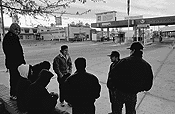
El Deportado-Part I

This is a picture of men standing outside of
the enterance to the border.
They are on the Mexican side of the Arizona-Mexico border.
"El Deportado"-Part
I:
Los Hermanos Ba–uelos
Voy a contarles se–ores, (2X)
Todo lo que yo sufr’.
Desde que dejŽ mi patria, (2X)
Por venir a este pa’s.
Ser’an las diez de la noche, (2X)
Comenz— un tren a silbar.
O’ que dijo mi madre,
--Ah’ viene ese tren ingrato
Que a mi hijo se va a llevar.--
--Adi—s mi madre querida, (2X)
HŽchame su benedici—n.
Yo me voy al extranjero, (2X)
Donde no hay revoluci—n.--
Corre, corre maquinita, (2X)
Vamonos de la estaci—n.
No quero ver a mi madre
Llorar por su hijo querido,
Por su hijo del coraz—n.
Al fin son— la campana, (2X)
Dos silbidos peg— el tren.
--No lloren mis compa–eros, (2X)
Que me hacen llorar tambiŽn.--
Pasamos pronto Jalisco, (2X)
Ay quŽ juerte corr’a el tren.
La Piedad, luego Irapuato,
Silado luego La Chona,
YAguascalientes tambiŽn.
Al recordar estas horas, (2X)
Me palpita el coraz—n.
Cuando devisŽ a lo lejos, (2X)
Aese mentado Torre—n.
Cuando Chihuahua pasamos, (2X)
Se not— gran confusi—n,
Los empleados de la aduana, (2X)
Que pasaban revisi—n.
"El Deportado" describes the sacrifices Mexicans would make to cross the border during the revolutionary era of the early 1900's. To this day Mexicans still come to the United States to have a better life, experiencing the same feelings that they felt back during the revolution.
The emotional core of this corrido is best defined by the following speech event in which the protagonist is saying good-bye to his family and friends as he is headed North.
Adi—s madre querida, (2X)
HŽcheme su benedici—n.
Yo me voy al estranjero,
Donde no hay revoluci—n.
In Mexico a "benedici—n," or prayer, is always given before a long trip. Here the protagonist's mother gives him a benedici—n as he leaves. The speech is important not because it describes what he is leaving behind but also why he is leaving. He is leaving Mexico to escape the bloody Revolution of 1910. He is going North to begin a new life but at the displeasure of his mother.
After the mentioned speech event a verse diade is used. "Corre, corre maquinita" is used mostly in corridos written during the revolution and after the revolution. In "El contrabando de El Paso", a prisoner's lament corrido, it is used to describe the train ride of the prisoner to Leavenworth, Kansas. In this corrido it is used to describe the protagonist's train ride as he is separated from his family. The rest of the first half of the corrido is used to describe the places he has passed to arrive at the US-Mexico border.
Througout the semester we used Armando Duvalier's six formulaic motifs. They include: 1) llamada inicial del corridista, 2) lugar, fecha y nombre del protagonista, 3) formula que , 4) mensaje, 5) la despedida del personaje, and 6) la despedida del corridista.To this point the corrido does meet a couple of Duvalier's formulaic motifs. It has a inicial del corridista and llamada inicial del personaje. This corrido is in first , which is unusual for corridos of that era. It does contain formulas and a message.
The second part of the song focuses on the
treatment of Mexican immigrants by US immigration officials. The
protagonist feels offended that the Americans do not want to
value the hispanic Pesos, and they also tell him that he must
bathe before entering the US. He almost decided to return, but
instead he finally crossed. When he is deported he is not
disappointed. His experience in the United States made him miss
his homeland more. The protagonist resents how the American's
treatment of the immigrants made them feel like criminals simply
because they were trying to escape the war. He, however, looks
forward to returning to Mexico because the war has ended.